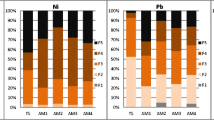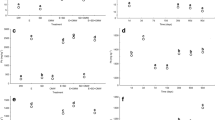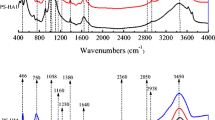Abstract
Organic matter (OM) plays a pivotal role in adsorptive behavior, speciation, and bioavailability of nutrients and metal(loids) in soils. However, the effects of OM on adsorption, fractionation, and bioavailability of antimony (Sb) in soils is largely unknown. In this study, the effects of two types of exogenous OM, including humic acid (HA) and fulvic acid (FA), on Sb bioavailability were compared in soils spiked with 1000 mg Sb kg-1 and incubated for 3 months under constant conditions. Treated soils were then subjected to single and sequential extractions using a Simplified Bioaccessibility Extraction Test (SBET) and BCR fractionation method as well as kinetic and desorption tests. Furthermore, SEM-EDX elemental maps of antimony were studies to better understand the distribution of antimony and its associations with soil elements. The kinetic data for amended and unamended soils fitted well with the pseudo-second order model, demonstrating that chemisorption might be the rate determining step. Bioaccessibility of antimony increased up to 65% in HA soils and OM additions increased acid-soluble fraction of Sb by approximately 40% (HA) and 75% (FA), compared to the control soils. OM amendments remarkably increased desorption of Sb from soils, whereas the maximum uptake capacity of Sb reduced in OM treated soils. The residual fraction accounted for 92% of total Sb in experimental soils, which was shifted to more labile fractions after OM amendments. The results of this research revealed that OM addition can greatly affect the bioaccessibility, distribution pattern and adsorption of Sb in Sb-impacted soils.
Graphical abstract











Similar content being viewed by others
Data availability
The authors declare that the data supporting the findings of this study are available within the paper and its figures and tables. Should any raw data files be needed in another format they will be made available from the corresponding author upon reasonable request.
References
Bagherifam, S., Brown, T. C., Fellows, C. M., & Naidu, R. (2019). Bioavailability of Arsenic and Antimony in Terrestrial Ecosystems: A Review. Pedosphere, 29, 681–720. https://doi.org/10.1016/S1002-0160(19)60843-X
Bagherifam, S., Brown, T. C., Fellows, C. M., & Naidu, R. (2021a). Highly efficient removal of antimonite (Sb (III)) from aqueous solutions by organoclay and organozeolite: Kinetics and Isotherms. Applied Clay Science, 203, 106004. https://doi.org/10.1016/j.clay.2021.106004
Bagherifam, S., Komarneni, S., Hullebusch, E., & Stjepanović, M. (2021b). Removal of antimonate (Sb(V)) from aqueous solutions and its immobilization in soils with a novel Fe(III)-modified montmorillonite sorbent. Environmental Science and Pollution Research, 29, 2073–2083. https://doi.org/10.1007/s11356-021-15765-7
Bagherifam, S., Brown, T.C., Bagherifam, S., Baglieri, A. (2023). Sequential extraction of labile and recalcitrant fractions of soil organic matter: A case study focusing on antimony (Sb) in humic acids, fulvic acids and humin fractions of long-term aged contaminated soils, Environmental Pollution, 327, 15 June 2023, 121610. https://doi.org/10.1016/j.envpol.2023.121610
Bittelli, M., Campbell, G. S., & Tomei, F. (2015). Soil Physics with Python, ISBN 978–0–19–968309–3. Oxford University Press.
Borch, T., Kretzschmar, R., Kappler, A., Cappellen, P., Ginder-Vogel, M., Voegelin, N., & Campbell, K. (2010). Biogeochemical Redox Processes and their Impact on Contaminant Dynamics. Environ. Sci. Technol, 44, 15–23. https://doi.org/10.1021/es9026248
Buschmann, J., Canonica, S., & Sigg, L. (2005). Photoinduced Oxidation of Antimony (III) in the Presence of Humic Acid. Environ. Sci. Technol, 39, 5335–5341. https://doi.org/10.1021/es050269o
Ettler, V., Kříbek, B., Majer, V., Knésl, I., & Mihaljevič, M. (2012). Differences in the bioaccessibility of metals/metalloids in soils from mining and smelting areas (Copperbelt, Zambia). J. Geochem. Explor, 113, 68–75. https://doi.org/10.1016/j.gexplo.2011.08.001
Fan, Y., Zheng, C., Huo, A., Wang, Q., Shen, Z., Xue, Z., & He, C. (2019). Investigating the binding properties between antimony(V) and dissolved organic matter (DOM) under different pH conditions during the soil sorption process using fluorescence and FTIR spectroscopy. Ecotoxicol Environ Saf, 181, 34–42. https://doi.org/10.1016/j.ecoenv.2019.05.076
Filella, M., Belzile, N., & Chen, Y. W. (2002). Antimony in the environment: a review focused on natural waters I. Occurrence. Earth Sci Rev., 57, 125–176. https://doi.org/10.1016/S0012-8252(01)00070-8
Guo, X., Zeng, L., Li, X., & Park, H. S. (2008). Ammonium and potassium removal for anaerobically digested wastewater using natural clinoptilolite followed by membrane pre-treatment. J Hazard Mater, 151, 125–133. https://doi.org/10.1016/j.jhazmat.2007.05.066
Hockmann, K., Lenz, M., Tandy, S., Nachtegaal, M., Janousch, M., & Schulin, R. (2014). Release of antimony from contaminated soil induced by redox changes. J Hazard Mater, 275, 215–221. https://doi.org/10.1016/j.jhazmat.2014.04.065
Karimian, N,, Burton, E.D., Johnston, S.G. (2019). Antimony speciation and mobility during Fe(II)-induced transformation of humic acid-antimony(V)-iron(III) coprecipitates. Environ Pollut, 254, 113112. https://doi.org/10.1016/j.envpol.2019.113112
Kleber, M., & Lehmann, J. (2019). Humic Substances Extracted by Alkali Are Invalid Proxies for the Dynamics and Functions of Organic Matter in Terrestrial and Aquatic Ecosystems. J Environ Qual, 48, 207–216. https://doi.org/10.2134/jeq2019.01.0036
Lagergren, S., Svenska, B. K. (1898). On the theory of so-called adsorption of dissolved substances, The Royal Swedish Academy of Sciences Document, Band 24, 1-13.
Li, C., Gao, S., Gao, Q., Wang, L., & Zhang, J. (2015). Characterization of bulk soil humin and its alkaline-soluble and alkaline-insoluble fractions. R. Bras. Ci. Solo, 39. https://doi.org/10.1590/01000683rbcs20150294
Li, J., Wei, Y., Zhao, L., Zhang, J., Shangguan, Y., Li, F., & Hou, H. (2014). Bioaccessibility of antimony and arsenic in highly polluted soils of the mine area and health risk assessment associated with oral ingestion exposure. Ecotoxicol Environ Saf, 110, 308–315. https://doi.org/10.1016/j.ecoenv.2014.09.009
Lindsay, M., Blowes, D., Ptacek, C. J., & Condon, P. (2011). Transport and attenuation of metal(loid)s in mine tailings amended with organic carbon: Column experiments. J. Contam. Hydrol, 125, 26–38. https://doi.org/10.1016/j.jconhyd.2011.04.004
Murphy, B. W. (2015). Impact of soil organic matter on soil properties-a review with emphasis on Australian soils. Soil Res, 53(6), 605–635. https://doi.org/10.1071/SR14246
Mitsunobu, S., Harada, T., & Takahashi, Y. (2015). Comparison of Antimony Behavior with that of Arsenic under various soil redox conditions. Environ. Sci. Technol, 40, 7270–7276. https://doi.org/10.1021/es060694x
Nakamaru, Y. M., & Martin Peinado, F. J. (2017). Effect of soil organic matter on antimony bioavailability after the remediation process. Environ Pollut, 228, 425–432. https://doi.org/10.1016/j.envpol.2017.05.042
Oorts, K., Smolders, E., Degryse, F., Buekers, J., Gascó, G., Cornelis, G., & Mertens, J. (2008). Solubility and toxicity of antimony trioxide (Sb2O3) in soil. Environ. Sci. Technol, 42, 4378–4383. https://doi.org/10.1021/es703061t
Öztaş, N. A., Karabakan, A., & Topal, Ö. (2008). Removal of Fe(III) ion from aqueous solution by adsorption on raw and treated clinoptilolite samples. Microporous Mesoporous Mater, 111, 200–205. https://doi.org/10.1016/j.micromeso.2007.07.030
Rauret, G., López-Sanchez, J. F., Sahuquillo, A., Rubio, R., Favidson, C., Ure, A., & Quevauviller, P. (1999). Improvement of the BCR three step sequential extraction procedure prior to the certification of new sediment and soil reference materials. J. Environ. Monit, 1, 57–61. https://doi.org/10.1039/A807854H
Robin, P., Morel, C., Vial, F., Landrain, B., Toudic, A., Li, Y., & Akkal-Corfini, N. (2018). Effect of three types of exogenous organic carbon on soil organic matter and physical properties of a sandy technosol. Sustainability, 10, 1146. https://doi.org/10.3390/su10041146
Ruby, M. V., Davis, A., Schoof, R., Eberle, S., & Sellstone, C. M. (1996). Estimation of lead and arsenic bioavailability using a physiologically based extraction test. Environ. Sci. Technol, 30, 422–430. https://doi.org/10.1021/es950057z
Seliem, M. K., Komarneni, S., Byrne, T., Cannon, F. S., Shahien, M. G., Khalil, A. A., & Abd El-Gaid, I. M. (2013). Removal of perchlorate by synthetic organosilicas and organoclay: Kinetics and isotherm studies. Appl. Clay Sci, 71, 21–26. https://doi.org/10.1016/j.clay.2012.10.008
Shuibo, X., Chun, Z., Xinghuo, Z., Jing, Y., Xiaojian, Z., & Jingsong, W. (2009). Removal of uranium (VI) from aqueous solution by adsorption of hematite. J Environ Radioact, 100, 162–166. https://doi.org/10.1016/j.jenvrad.2008.09.008
Stevenson, F.J. (1994). Humus chemistry: Genesis, composition, and reactions. New York: John Wiley and Sons. ISBN: 978-0-471-59474-1
Tella, M., & Pokrovski, G. S. (2008). Antimony(V) complexing with O-bearing organic ligands in aqueous solution: an X-ray absorption fine structure spectroscopy and potentiometric study. Mineral. Mag, 72, 205–209. https://doi.org/10.1180/minmag.2008.072.1.205
Tella, M., & Pokrovski, G. S. (2009). Antimony(III) complexing with O-bearing organic ligands in aqueous solution: An X-ray absorption fine structure spectroscopy and solubility study. Geochimica et Cosmochimica. Acta, 73, 268–290. https://doi.org/10.1016/j.gca.2008.10.014
Thanabalasingam, P., & Pickering, W. F. (1990). Specific sorption of antimony(III) by the hydrous oxides of Mn. Fe, and Al., 49, 175–185. https://doi.org/10.1007/BF00279519
Verbeeck, M., Hiemstra, T., Thiry, Y., & Smolders, E. (2017). Soil organic matter reduces the sorption of arsenate and phosphate: a soil profile study and geochemical modelling. Eur. J. Soil Sci, 68, 678–688. https://doi.org/10.1111/ejss.12447
Verbeeck, M., Warrinnier, R., Gustafsson, J. P., Thiry, Y., & Smolders, E. (2019). Soil organic matter increases antimonate mobility in soil: An Sb(OH)6 sorption and modelling study. Appl. Geochem, 104, 33–41. https://doi.org/10.1016/j.apgeochem.2019.03.012
Verbeeck, M., Thiry, Y., & Smolders, E. (2020). Soil organic matter affects arsenic and antimony sorption in anaerobic soils. Environ Pollut, 257, 113566. https://doi.org/10.1016/j.envpol.2019.113566
Zhang, H., Li, L., & Zhou, S. (2014). Kinetic modelling of antimony(V) adsorption-desorption and transport in soils. Chemosphere, 111, 434–440. https://doi.org/10.1016/j.chemosphere.2014.04.054
Zhang, S., Wang, Y., Pervaiz, A., Kong, L., & He, M. (2018). Comparison of diffusive gradients in thin-films (DGT) and chemical extraction methods for predicting bioavailability of antimony and arsenic to maize. Geoderma, 332, 1–9. https://doi.org/10.1016/j.geoderma.2018.06.023
Acknowledgements
The first author Saeed Bagherifam gratefully acknowledges the scholarship provided by the University of New England, Australia for his PhD program. We thank the Environmental Analysis Laboratory (EAL) of the Southern Cross University NATA (National Association of Testing Authorities) ISO17025 accredited commercial and research support facility for assisting in the characterization of soil samples.
Author information
Authors and Affiliations
Contributions
Saeed Bagherifam: Conceptualization, Investigation including performing the experiments and data collection, Formal analysis, Methodology, Writing - original draft, review and editing. Trevor C. Brown: Review & editing, Supervision. Prof. Eric D. van Hullebusch: Constructive suggestions for improving manuscript, Review & editing. Ravi Naidu: Review & editing, Supervision.
Corresponding author
Ethics declarations
Conflict of interests
☒ The authors declare that they have no known competing financial interests or personal relationships that could have appeared to influence the work reported in this paper.
☐ The authors declare the following financial interests/personal relationships which may be considered as potential competing interests
Additional information
Publisher’s Note
Springer Nature remains neutral with regard to jurisdictional claims in published maps and institutional affiliations.
Highlights
Organic amendments decrease the maximum adsorption capacity of Sb in soil.
Percent desorption of Sb in soils increases in organic matter amended soils
Organic amendments increase the bioaccessibility of Sb by up to 65%.
Labile fraction of Sb rises by 75% with organic amendments.
Organic amendments can increase soil bioavailability and bioaccessibility of Sb.
Rights and permissions
Springer Nature or its licensor (e.g. a society or other partner) holds exclusive rights to this article under a publishing agreement with the author(s) or other rightsholder(s); author self-archiving of the accepted manuscript version of this article is solely governed by the terms of such publishing agreement and applicable law.
About this article
Cite this article
Bagherifam, S., Brown, T.C., Naidu, R. et al. The effects of exogenous organic matter addition on bioaccessibility, adsorption kinetics and fractionation of antimony in soils. Water Air Soil Pollut 234, 580 (2023). https://doi.org/10.1007/s11270-023-06607-y
Received:
Accepted:
Published:
DOI: https://doi.org/10.1007/s11270-023-06607-y




